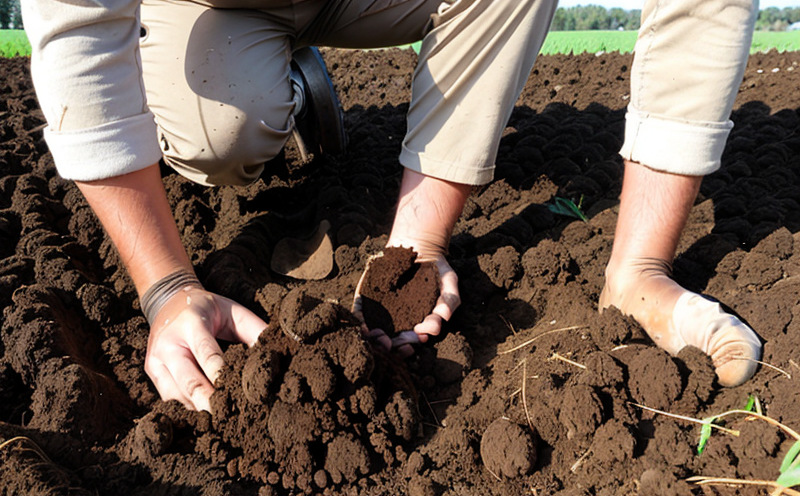Soil Microbial Biomass Nitrogen Testing
The soil microbial biomass nitrogen (SMBN) test is a critical tool in assessing the health and productivity of agricultural soils. SMBN testing quantifies the total amount of nitrogen present in the living microbial biomass, which plays a pivotal role in nutrient cycling within the soil ecosystem. This test is essential for understanding the biological activity and fertility status of the soil, providing insights into its ability to support plant growth.
Microbial life in soil is the foundation upon which agricultural productivity is built. Microbes decompose organic matter, cycle nutrients, and interact with plants through symbiotic relationships such as nitrogen fixation. By measuring SMBN, we can gauge how efficiently these processes are occurring. This information helps in formulating strategies to enhance microbial activity, improve soil structure, and ultimately boost crop yields.
The test is particularly valuable for farmers, quality managers, and R&D engineers who aim to optimize agricultural practices based on scientific data. By tracking SMBN levels over time, one can identify trends that indicate changes in soil health due to management practices or environmental factors. This knowledge is crucial for sustainable agricultural operations, as it allows for targeted interventions aimed at maintaining or restoring soil fertility.
Technologically advanced methods such as the phosphomolybdate assay are employed in SMBN testing. These assays measure the total nitrogen content of microbial biomass, which can then be correlated with other soil properties like pH and organic matter content to provide a comprehensive picture of soil health. The results from this test serve as a benchmark for monitoring the effectiveness of various agricultural interventions such as fertilization, crop rotations, or the use of biofertilizers.
Understanding SMBN is not just about current conditions; it also provides a baseline against which future changes can be measured. This makes SMBN testing an indispensable component in any comprehensive soil management program aimed at enhancing sustainability and productivity. Whether you're a farmer looking to optimize crop yields or a researcher studying the impacts of climate change on agricultural ecosystems, SMBN testing offers valuable insights into the complex interactions within the soil microbiome.
- Assesses biological activity and fertility status
- Identifies trends in soil health over time
- Guides targeted interventions for enhanced productivity
- Maintains sustainability through informed decision-making
Why Choose This Test
The SMBN test stands out as an essential tool for agricultural and forestry testing due to its unique ability to provide a snapshot of soil microbial health. Unlike traditional chemical analyses, SMBN tests offer a direct measure of the living component of soil ecosystems, which is often overlooked in conventional assessments.
- Direct measurement of microbial biomass
- Provides insights into biological activity and fertility status
- Supports sustainable agricultural practices by offering data for informed decision-making
- Identifies trends over time to monitor the effectiveness of soil management strategies
- Aids in diagnosing specific issues such as nutrient deficiencies or microbial imbalances
- Compliant with internationally recognized methods, ensuring accuracy and reliability
The SMBN test is particularly beneficial for those involved in quality assurance and compliance. Its ability to provide real-time data on soil health allows stakeholders to make timely adjustments to their practices. For R&D engineers, this test offers a valuable tool for exploring new approaches to improve soil fertility and crop yields.
By choosing SMBN testing, organizations can gain a competitive edge by ensuring that they are at the forefront of sustainable agricultural practices. This test not only supports current operations but also sets a foundation for future improvements in soil management.
International Acceptance and Recognition
The SMBN test has gained widespread acceptance across international standards such as ISO, ASTM, EN, and IEC. These organizations recognize the importance of SMBN testing in assessing soil health and have developed methodologies that ensure consistency and reliability across different regions.
ISO 17025, for instance, sets global standards for the competence of testing and calibration laboratories, ensuring that SMBN tests conducted adhere to the highest scientific and technical standards. Similarly, ASTM standards provide specific protocols for sample preparation and analysis, which are widely adopted in both academic research and industrial applications.
EN (European Norm) and IEC (International Electrotechnical Commission) also contribute significantly to the acceptance of SMBN tests by providing harmonized approaches that facilitate international collaboration. The recognition of these standards ensures that results from SMBN testing are credible and can be compared across borders, making it easier for global stakeholders to adopt best practices.
The international acceptance of SMBN testing underscores its importance in the agricultural sector. By adhering to these recognized standards, laboratories ensure that their services meet the highest quality benchmarks, thereby enhancing trust among clients and stakeholders.
Environmental and Sustainability Contributions
Incorporating SMBN testing into your environmental management strategy can have profound benefits for sustainability. By measuring microbial biomass nitrogen, you gain a deeper understanding of soil health, which is crucial for developing effective strategies to enhance productivity while minimizing environmental impact.
The data provided by SMBN tests can help in implementing precision agriculture practices that optimize resource use and reduce waste. For example, knowing the exact amount of nitrogen available from microbes allows farmers to adjust their fertilization schedules more accurately, thus reducing the risk of runoff into water bodies and decreasing the need for synthetic fertilizers.
Moreover, SMBN testing supports biodiversity conservation efforts by promoting practices that enhance soil health. Healthy soils are better equipped to support a wide range of organisms, which in turn contribute to ecosystem stability and resilience. This aligns with broader sustainability goals aimed at creating more resilient agricultural systems capable of adapting to climate change.
In addition, SMBN testing can help in carbon sequestration efforts by identifying soil management practices that increase the microbial biomass, thus enhancing the soil's capacity to store carbon. This dual benefit of improving productivity and reducing greenhouse gas emissions makes SMBN testing an integral part of sustainable agricultural initiatives worldwide.





